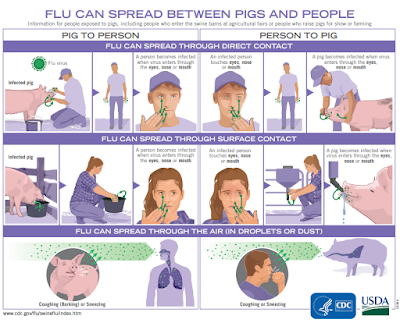#17,010
Earlier this week Michigan DOH Announced A Novel Swine Variant H1N2v Infection Linked To A County Fair - the 6th such case reported in the United States since early August - and today the CDC reports a 7th, this time in Wisconsin.
Both cases involved the swine variant H1N2v virus - which up until 2017 was the least common swine variant reported - but since then has become the most common.
So far this summer we are not seeing any signs of human-to-human transmission, although it has been documented with swine variant viruses in the past. That said, surveillance and testing for swine variant viruses is sporadic at best, and it is likely that many cases go unidentified.
The CDC's FluView provides very little information on the Wisconsin case stating it is under investigation, and so far, I haven't found anything on the Wisconsin DOH website.
Two human infections with a novel influenza A virus were reported during week 36 (Michigan and Wisconsin). Both patients were infected with influenza A(H1N2) variant (A(H1N2)v) viruses.
The Michigan Department of Health and Human Services reported one infection in a patient <18 years of age. The patient was not hospitalized and has recovered from their illness. An investigation by local public health officials found that the patient had attended an agricultural fair prior to their illness onset. Additional investigation identified one household contact who had respiratory illness. This contact attended the same agricultural fair and became ill at the same time as the patient. No person-to-person transmission of A(H1N2)v virus associated with this patient has been identified.
The Wisconsin Department of Health reported one infection in a patient < 18 years of age. An investigation by local public health officials is ongoing.
A total of seven human infections with variant novel influenza A viruses have been reported in the United States in 2022, including three H3N2v (West Virginia) and four H1N2v (Michigan, Ohio, Oregon, Wisconsin) viruses. When an influenza virus that normally circulates in swine (but not people) is detected in a person, it is called a “variant influenza virus.” Most human infections with variant influenza viruses occur following exposure to swine, but human-to-human transmission can occur. It is important to note that in most cases, variant influenza viruses have not shown the ability to spread easily and sustainably from person to person. Early identification and investigation of human infections with novel influenza A viruses are critical so that the risk of infection can be understood, and appropriate public health measures can be taken.
Additional information on influenza in swine, variant influenza virus infection in humans, and guidance to interact safely with swine can be found at www.cdc.gov/flu/swineflu/index.htm.
While the pandemic risk from swine variant viruses is currently believed to be low, these viruses continue to reinvent themselves as they circulate in pigs, and so we pay very close attention whenever they jump species to humans.Additional information regarding human infections with novel influenza A viruses can be found at http://gis.cdc.gov/grasp/fluview/Novel_Influenza.html.
For more on this summer's swine variant uptick, you may wish to revisit:
EID Journal: Shortening Duration of Swine Exhibitions to Reduce Risk for Zoonotic Transmission of Influenza A Virus
CDC HAN #00473: Variant Influenza Virus Infections: Recommendations for Identification, Treatment, and Prevention for Summer and Fall 2022
CDC FluView Week 33: Ohio Reports the 5th Novel Swine Variant (H1N2v) Virus of 2022
CDC FluView Week 31: 2 More Novel H3N2v Cases Reported Out of West Virginia
